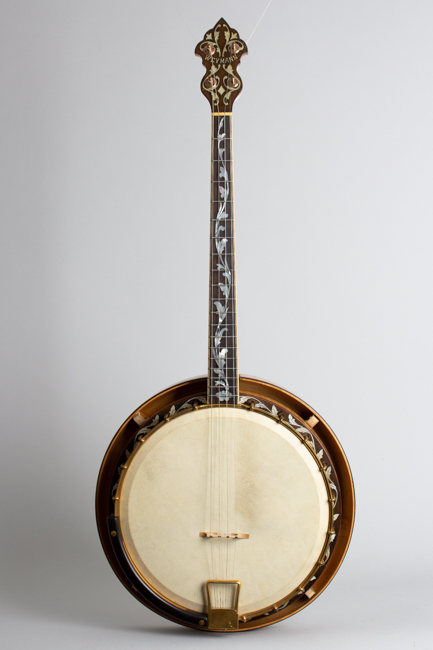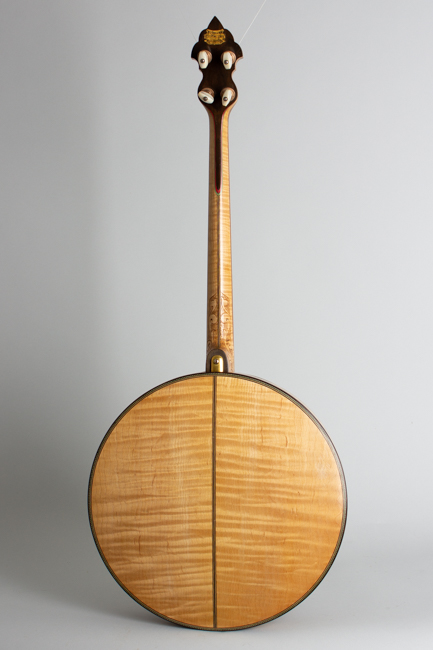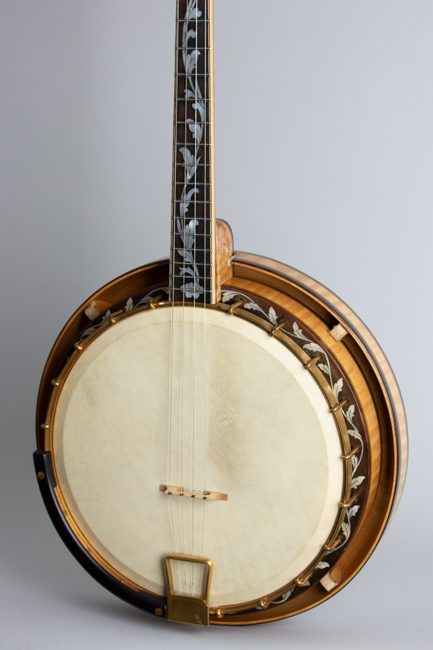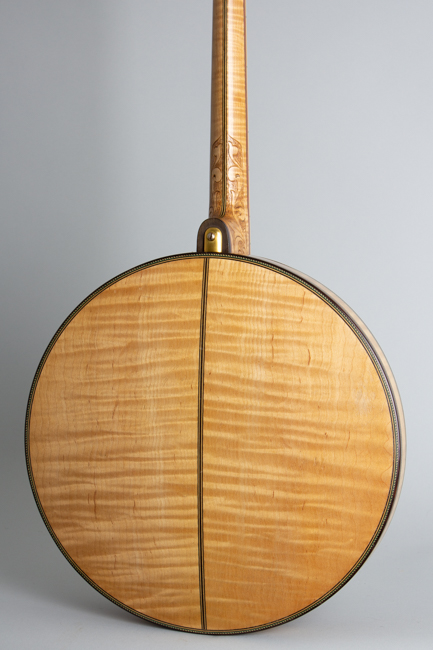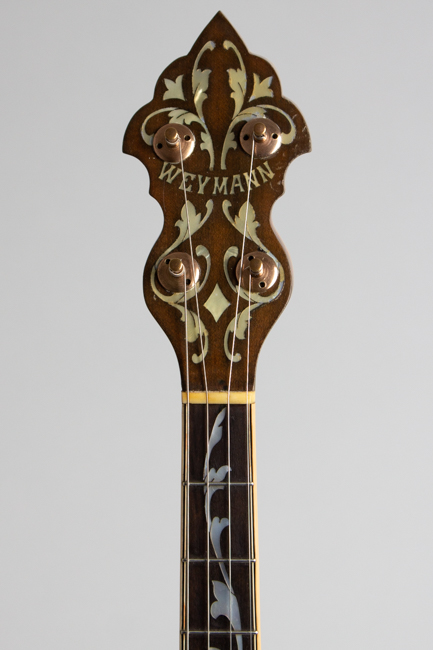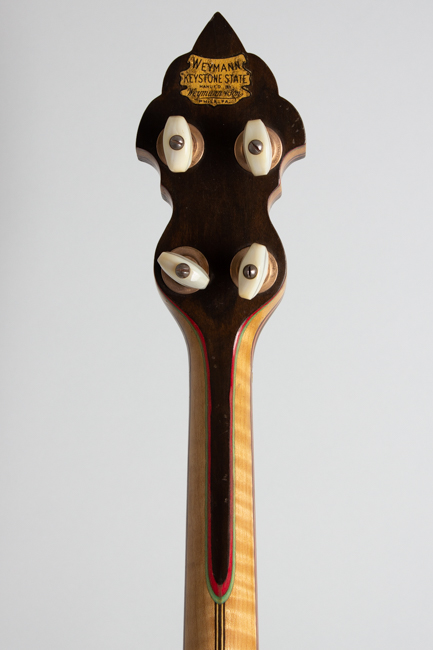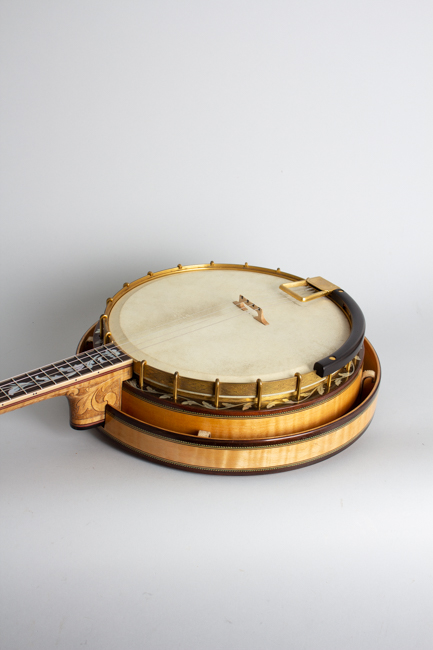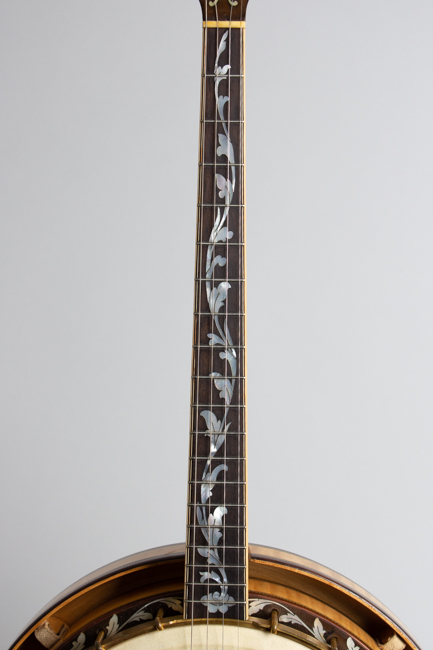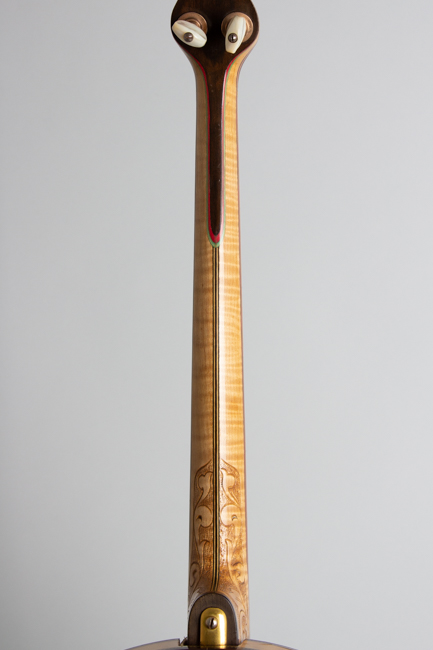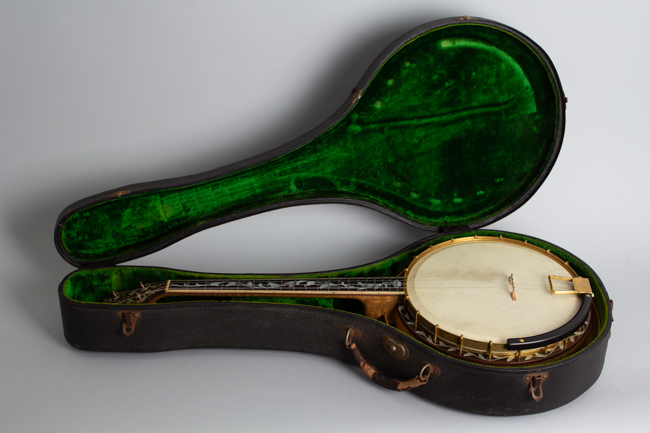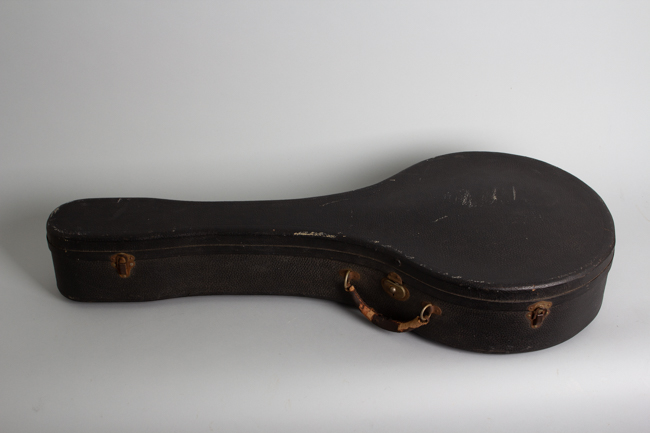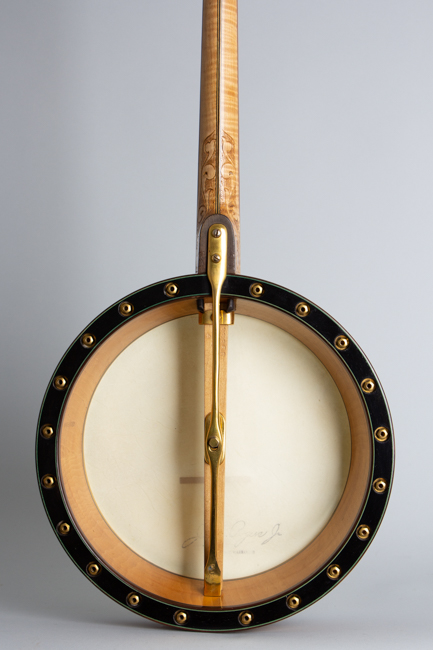Weymann Orchestra Style 4 Tenor Banjo (1923)
This item has been sold.
Item # 10317
Prices subject to change without notice.
Weymann Orchestra Style 4 Model Tenor Banjo (1923), made in Philadelphia, PA, serial # 33356, natural varnish finish, laminated maple neck, rim and resonator; ebonized fingerboard, original black hard shell case.
This Style 4 Orchestra Model was one of the top-end offerings in Weymann's 1920's "Megaphonic" professional banjo line, some of the most elegant of all 1920s banjo designs. This superbly high quality instrument retailed originally in 1923-4 at $320.00; a Ford model T runabout that same year was only $265! Like most Weymann banjos, this is an extremely finely made instrument with the company's customary attention to detail evident everywhere. This example is a very early Style 4 from the first months of production, amazingly well preserved over nearly 100 years.
The Megaphonic line feature many unique features, most notably a patented wood rim with the hooks running through it, eliminating the metal bracket shoes and attendant hardware. It is capped with a very heavy solid archtop tone ring, designed years before Gibson's. The inner surface of the rim is angled backwards like a megaphone (hence the name) and the inside of the resonator is carved in a cupped pattern, supposedly to focus the sound unimpeded by sharp angle traps.
The Style 4 is a VERY fancy banjo, even by the elaborate standards of the day. Made primarily of natural-finished maple it is rather more tasteful in appearance than many competitors with a lack overtly gaudy touches. The neck is laminated from solid maple with multiple colored wood laminations in the center and underlaying the fingerboard. The triple-bound fingerboard is inlaid with fancy shaped pearl pieces in a continuous vine pattern.
The headstock overlay carries a "Weymann" logo of inlaid pearl letters with an elaborate floral design, and there is a gold "Weymann Keystone State" decal on the back. It mounts the earliest version of the company's elegant patented recessed tuning pegs. The heel is carved in a floral pattern with a heavy multi-laminate heelcap.
All hardware is gold-plated and the hoop, tone ring sheath, and tailpiece heavily engraved. The rim and resonator are laminated maple with multiple binding and half-herringbone wood marquetry on every edge. The rim top has inlaid pearl in a continuous floral pattern. There is a natural ebony armrest mounted to the hoop, another stylish unique Weymann feature.
This very early banjo does not have a metal flange capping the resonator top rim, a feature added to later Megaphonic models. The resonator is held in place by heavy spring clips and pops off easily, by far the neatest and most convenient of all such systems. There is a heavy adjusting bracket mounted under the dowel which allows limited adjustment of the neck angle, another Weymann innovation. This is simply a great sounding and superbly classy tenor banjo, a fantastic top-line instrument in the 1920s or today!
Overall length is 34 in. (86.4 cm.), 11 in. (27.9 cm.) diameter head, and 3 7/16 in. (8.7 cm.) in depth, measured at side of rim. Scale length is 22 in. (559 mm.). Width of nut is 1 1/8 in. (29 mm.).
This banjo appears to have seen very little use over nearly ten decades and shows only some very minor wear, remaining in exceptionally fine playing all-original condition. The gold plating shows only light wear; the hoop, hooks, tuners and tailpiece have a lovely aged patina but not much plating loss. The thin varnish finish shows similarly minor wear overall , mostly dings and dents to the back of the resonator.
The back of the neck, frets and fingerboard show some very few signs of play, remaining nearly pristine. The banjo is set up with a period (Probably original) Rogers Union Brand skin head with a bit of finger scuffing on the top surface and the original thin maple and ebony Weymann bridge. It plays and sounds great, very powerful but not as brash sounding as many tenors. This is simply a superb instrument in every way, one of the nicest 1920s pieces we have seen in a long time. It still rests in the original HSC which is a tight fit but shows only some minor wear, mostly to the handle. Excellent + Condition.
This Style 4 Orchestra Model was one of the top-end offerings in Weymann's 1920's "Megaphonic" professional banjo line, some of the most elegant of all 1920s banjo designs. This superbly high quality instrument retailed originally in 1923-4 at $320.00; a Ford model T runabout that same year was only $265! Like most Weymann banjos, this is an extremely finely made instrument with the company's customary attention to detail evident everywhere. This example is a very early Style 4 from the first months of production, amazingly well preserved over nearly 100 years.
The Megaphonic line feature many unique features, most notably a patented wood rim with the hooks running through it, eliminating the metal bracket shoes and attendant hardware. It is capped with a very heavy solid archtop tone ring, designed years before Gibson's. The inner surface of the rim is angled backwards like a megaphone (hence the name) and the inside of the resonator is carved in a cupped pattern, supposedly to focus the sound unimpeded by sharp angle traps.
The Style 4 is a VERY fancy banjo, even by the elaborate standards of the day. Made primarily of natural-finished maple it is rather more tasteful in appearance than many competitors with a lack overtly gaudy touches. The neck is laminated from solid maple with multiple colored wood laminations in the center and underlaying the fingerboard. The triple-bound fingerboard is inlaid with fancy shaped pearl pieces in a continuous vine pattern.
The headstock overlay carries a "Weymann" logo of inlaid pearl letters with an elaborate floral design, and there is a gold "Weymann Keystone State" decal on the back. It mounts the earliest version of the company's elegant patented recessed tuning pegs. The heel is carved in a floral pattern with a heavy multi-laminate heelcap.
All hardware is gold-plated and the hoop, tone ring sheath, and tailpiece heavily engraved. The rim and resonator are laminated maple with multiple binding and half-herringbone wood marquetry on every edge. The rim top has inlaid pearl in a continuous floral pattern. There is a natural ebony armrest mounted to the hoop, another stylish unique Weymann feature.
This very early banjo does not have a metal flange capping the resonator top rim, a feature added to later Megaphonic models. The resonator is held in place by heavy spring clips and pops off easily, by far the neatest and most convenient of all such systems. There is a heavy adjusting bracket mounted under the dowel which allows limited adjustment of the neck angle, another Weymann innovation. This is simply a great sounding and superbly classy tenor banjo, a fantastic top-line instrument in the 1920s or today!
Overall length is 34 in. (86.4 cm.), 11 in. (27.9 cm.) diameter head, and 3 7/16 in. (8.7 cm.) in depth, measured at side of rim. Scale length is 22 in. (559 mm.). Width of nut is 1 1/8 in. (29 mm.).
This banjo appears to have seen very little use over nearly ten decades and shows only some very minor wear, remaining in exceptionally fine playing all-original condition. The gold plating shows only light wear; the hoop, hooks, tuners and tailpiece have a lovely aged patina but not much plating loss. The thin varnish finish shows similarly minor wear overall , mostly dings and dents to the back of the resonator.
The back of the neck, frets and fingerboard show some very few signs of play, remaining nearly pristine. The banjo is set up with a period (Probably original) Rogers Union Brand skin head with a bit of finger scuffing on the top surface and the original thin maple and ebony Weymann bridge. It plays and sounds great, very powerful but not as brash sounding as many tenors. This is simply a superb instrument in every way, one of the nicest 1920s pieces we have seen in a long time. It still rests in the original HSC which is a tight fit but shows only some minor wear, mostly to the handle. Excellent + Condition.
